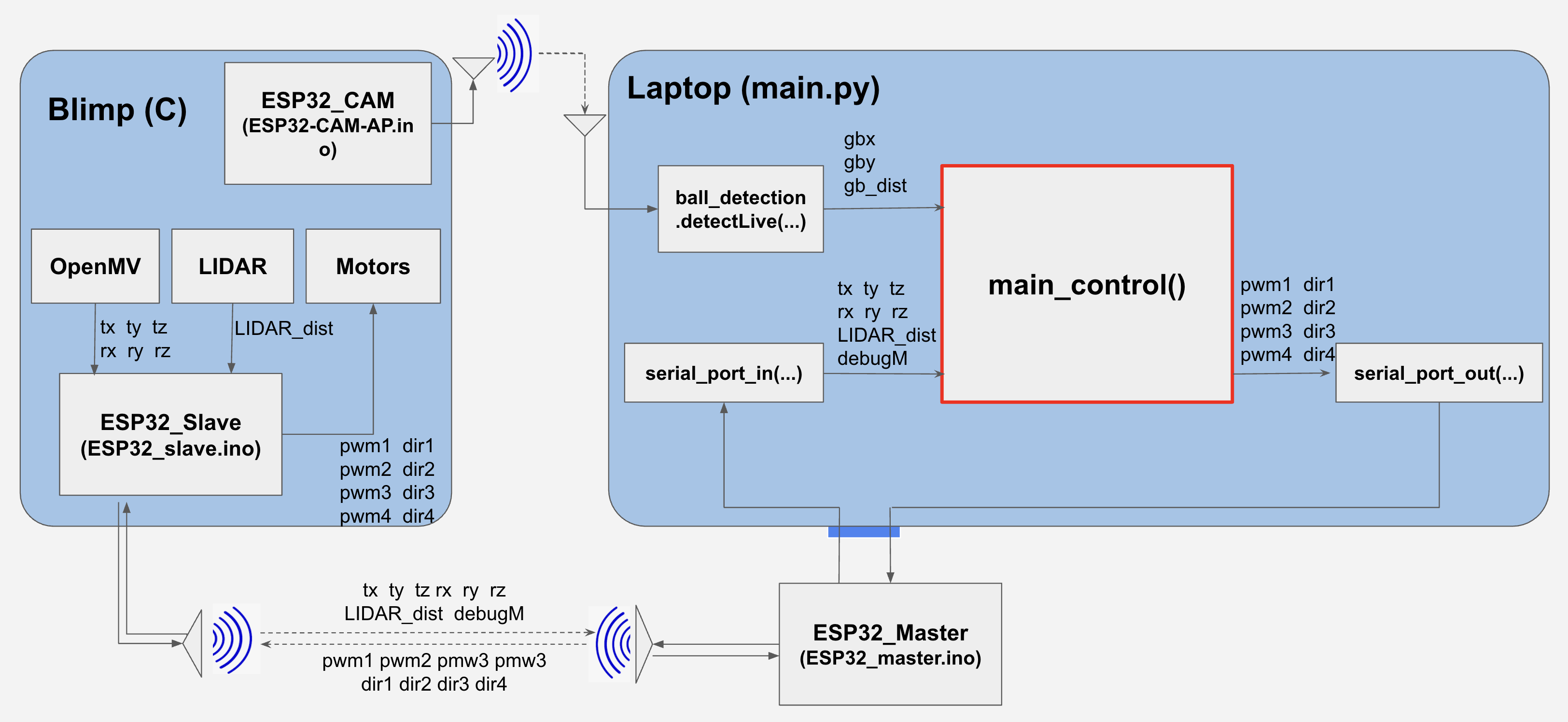FORAY - P2P Blimp-Laptop System: Seek and Catch Green Ball Capability Achieved (tested on blimp), MoveToGoal Code Written (to be tested on blimp --> Update: DONE)
Zhiying Li (Steven)Based on Wednesday Meeting, we decide to change our whole system design into a P2P Blimp-Laptop version, so that all controlling process happens on the ground i.e on the laptop. And blimp system is only for (1) get and send sensing data (2) receive laptop processed motor directives (3) control motor based on received motor directives.
The one that we debugged last night:
The advantage with this system design are:
- all control code on the laptop can be written with python, instead of C
- field testing and debugging process becomes quick, as can all of the control logic happens on the laptop
What we have achieved for (10/22/2021 2:51PM):
- Seek and Catch Green Ball Capability Achieved (tested on blimp)
- MoveToGoal Code Written (to be tested on blimp)
Update: What we have achieved for (10/23/2021 1:44PM):
-
MoveToGoal Code Capability Achieved (tested on blimp)
--> this means all 3 capabilities (seek, move2ball, move2goal) are prove to run intergratedly and smoothly on the blimp system. all remaining are fine tuning.
--> refer to Zhaoliang next blog post for the video and details
P2P Blimp-Laptop I/O
The current version modularized P2P Blimp-Laptop I/O is the following diagram:

LapTop Input-Control-Output pipeline
In our main.py, for every "loop forever" iteration ( takes 0.05 seconds, defined by waitTime), we finish one Input-Control-Output pipline:
-
Taking input:
- (C) ESP32Cam HotSpot --> (python) read at local IP --> feed into Pytorch Green ball dectection model --> receive
gbx,gby, andarea - (C) ESP32_Master conducts serial port print of what's coming from ESP32_Slave, with line
SERIAL_IN_STARTas where to start reading_ --> (Python) always read every line at the laptop-ESP32 port --> whenever detectSERIAL_IN_START, read next 8 line. Each aretx,ty,tz,rx,ry,rz,LIDAR_dist, anddebugM
Note:
- (A bug that bothered us, now fixed) To avoid lagging, delay(50) should be there in ESP32_Slave, and the serial_port_in and serial_port_out() must sync in time--> ([Update on 10/23/2022 1:42PM] for more details, please refer to the integrated blog post to see the resulthow Zhaoliang and I solved this issue.)
- To make ESP32_SLAVE talks first. In
main.py, right beforewhile Ture:, we need to oneserial_port_outcall on ESP32_Master first, to trigger ESP32_Slave to talk.
- (C) ESP32Cam HotSpot --> (python) read at local IP --> feed into Pytorch Green ball dectection model --> receive
-
Feed input to control, and do the control:
There is a big block of function called
main_control(...)whose IO arepwm1, pwm2, pwm3, pwm4, dir1, dir2, dir3, dir4 = main_control(gbx, gby, gb_dist, tx, ty, tz, rx, ry, rz, LIDAR_dist, debugM)It takes all input, and outputs motor actions
In this function, it contains THE control logic of blimps strategy.
Note:
- This entire part can be written entirely using Python.
main_control(...)has it own submodules for different actions. They are:seeking(), Code: DONE, bug-free | Test on Blimp: DONEmove2ball(), Code: DONE, bug-free | Test on Blimp: DONE ---> Check the video- ----- **Update on 10/23/2021 1:44AM ------
move2goal(), Code: DONE, bug-free | Test on Blimp: DONE ---> refer to Zhaoliang next blog post for the video and details
-
Feeding output:
- (python) we format the
pwm1, pwm2, pwm3, pwm4, dir1, dir2, dir3, dir4in string --> we write it to the serial port --> (C) ESP32_Master interprets it and send to ESP32_Slave
Note: the format is
pwm1, pwm2, pwm3, pwm4each takes 3 position, anddir1, dir2, dir3, dir4each take on position1, 22, 333, 444, +, +, -, -------->b'001022333444++--'
- (python) we format the
Video
Thursday night flying test:
After we fixed the green ball feedback control delay bug: